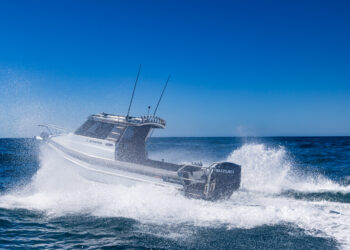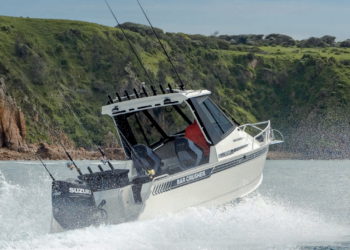If you’re a muscle car enthusiast, then you’ll know that there’s no substitute for cubic inches. Someone in the R&D department at Mercury must be a bit of a rev head because the US-based marine engine company has followed that old hot rod credo and applied it to the development of its latest mid-sized outboard.
The result is that Mercury has produced a 150hp four-stroke engine boasting 183 cubic inches of displacement (that’s three litres in our metric system). Compared to rival products, the Merc offers significantly more engine capacity.
Despite the extra cubes, it’s also lighter and more compact than its competitors.
The basic idea of a “big” engine is that it doesn’t have to work hard to produce horsepower. A three-litre block is more commonly associated with outboards in the 200-250hp class. An engine of this size producing just 150hp has an obvious advantage in that the large displacement block can produce power and torque more effectively. The other big advantage of an engine like this is that it operates with minimal stress or strain. It doesn’t have to push the limits to develop the required horsepower. This should equate to an engine with outstanding longevity, especially when used in typical rec-fishing situations.
Mercury has taken a pretty interesting line with this new engine, especially when you compare it against the Verado range. Mercury led the way in outboard performance when it introduced these unique four-strokes about a decade ago. For those who don’t recall the hoopla about these radical donks, the Verado concept is based on fairly small capacity engines that use technological enhancements (a super charger system) to develop horsepower and performance. While still producing its Verado range, Mercury is now offering what can be seen as a more “traditional” engine. That said, the normally aspirated four-cylinder 150 is a bit of a groundbreaker in that it takes the recent trend of making four-strokes smaller, lighter and more responsive to the next level.
Plenty of grunt
I recently fitted a test Mercury 150 Four-Stroke in XL shaft to the transom of the Fisho Bar Crusher 670C in order to assess engine performance in typical fishing situations. I’ve done about 30 hours of cruising and trolling so far and have performed preliminary speed and fuel performance tests.
The previous test engine was a 175hp Evinrude E-TEC DI two-stroke (see write up and performance data in the December 2012 edition). I obviously can’t compare these two engines as the E-TEC boasts 25hp more than the Merc. But I’m planning on running a 150hp comparison – similar to the 200hp engine series I did with the Fisho Stabi some years back – so over time I should be able to give head-to-head assessment of all the major 150hp outboards currently available.
To be honest, going from a 175 DI two-stroke to a 150hp four-stroke hasn’t been that much of a change. The 2.6l V6 E-TEC had typical DI two-stroke punch – it’s hard to beat that instant two-stroke acceleration! – but the Merc has proven to be surprisingly toey as well. There’s no doubt that four-strokes have come a long way. The newest models, like this 150 and Yamaha’s new four-cylinder 200, are much more responsive than the sluggish versions of a decade or so ago. The new age four-strokes as yet don’t have the same neck-snapping torque of two-strokes like the E-TEC and Mercury’s Optimax, but they are without doubt fast closing the gap.
The Merc gets the 6.7m Bar Crusher up on the plane in just over four seconds and displays good throttle responsiveness throughout the rev range. I have driven four-strokes that seem to “labour” in regards to getting a boat out of the hole but the three-litre 150 doesn’t even raise a sweat when it comes to pushing the plate alloy Crusher along. It makes no difference if I’m driving solo or with a couple of mates and a full load of gear on board – to date, the engine has performed with no obvious signs of stress or strain. That, to my way of thinking, exemplifies the benefit of cubic inches … there’s obviously plenty of power in reserve with this particular donk. You’d have to think that Mercury would be modifying this three-litre block to suit other horsepower ranges. I wouldn’t be surprised to see a 200 or even 250hp version at some stage …
Apart from power and performance, the other innovation Mercury has introduced with this 150 is a substantial weight reduction. At 206kg (dry weight), the Merc is lighter than all other 150 four-strokes currently available. It’s actually getting pretty close to DI two-stroke weights, being just 11 kilos heavier than the 150hp Optimax. Shaving weight means that engines like the Merc 150 are now suited to boats that previously could only support two-stroke technology.
I want to do quite a few more hours and get a better feel for this engine before I write any sort of definitive test or analysis. As it stands now, I’d like to experiment with different props in order to attain maximum efficiency and performance. The engine was initially fitted with a 17” Vengeance stainless steel prop which was then swapped by the Mercury technicians for a 17” Enertia SS model. I’m happy with the performance in the key trolling and cruising rev ranges but wouldn’t mind more top end speed if possible. There’s also a low RPM rattle that a different prop might fix.
In conclusion, my initial impressions of this engine are that there’s a lot to like. It’s compact, looks fantastic (I love the Darth Vader inspired cowl shape!), is typically four-stroke quiet, seems pretty good on the fuel, trolls really well and boasts a heap of features and interesting technical features that I’m looking forward to assessing and testing out. It’s also priced extremely competitively.
Stay tuned!




















